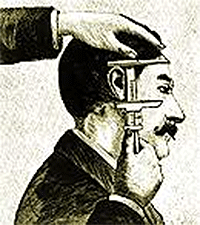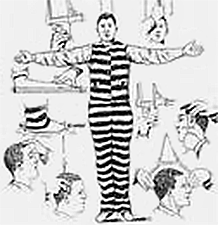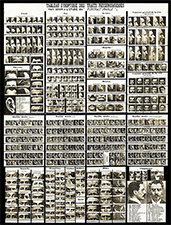The Bertillon System of Identification
by
Edward J. "Ed" Steenberg, Saint Paul Police Historical Society
During one of my recent visits to the Minnesota Historical Society (MN History Center) I ran across an interesting collection of Saint Paul Police Department Mug Shots. The collection consists of 125 mug shots and 85 Bertillon cards which originated with, or were used by, the Saint Paul Police Department, and documents the identification and incarceration of criminals thought to be in the City of Saint Paul and surrounding areas from 1891 through 1911.
"House sneak," "Safe blower," and "swindler" were not uncommon criminal occupations, and tattoos, scars, moles and physical shortcomings were duly noted. One card in the collection describes a criminal as follows: "Walks slightly pigeon-towed, slightly stooped shoulders, round lump on the top and back of head…"
Most of the mug shot cards were created by the Saint Paul Police Department, but some originated in other cities' police departments, including Duluth, Minneapolis, Superior (Wisconsin), Chicago, Kansas City, Fargo, Denver, and New Orleans. Most are marked "Personal Property Jno. [John] J. O'Connor1," presumably the same John J. O'Connor who was Chief of Police for the City of Saint Paul from 1900 to 1912 and from 1914 to 1920.
The mug shot cards are 4 by 2½ inches (pocket size) with a photo of the criminal on the front and the criminal's name, alias(es), residence, legitimate and criminal occupations, physical measurements, features and "peculiarities" on the back.
The Bertillon cards are 6 by 5½ inches, offering front/profile photographs of the criminal and Bertillon measurements on the front of the card, while the back lists information similar to the mug shot cards. The Bertillon System was an improvement of identification over simple mug shots and basic physical measurements, and was a forerunner to fingerprinting. It was developed by French criminologist Alphonse Bertillon in the early 1880s to increase the accuracy of criminal identification by measuring certain bony portions of the body, including the skull, foot, cubit, trunk and left middle finger. This identification method spread throughout Europe and was introduced into the United States in 1887.



The Bertillion System of Measurements
For instructions and additional photos on taking measurements and descriptions by the Bertillion System for identification of criminals, go to History of the Police and Fire Departments of the Twin Cities, 1899, a publication found on the SPPHS Website.
Part of its benefit was that by arranging the records carefully, it would be very easy to sift through a large number of records quickly given a few measurements from the person to be identified. While it might not always give an exact match, it would allow one to narrow the pool of possible people and then to compare the person with a photograph.
The system was eventually found to be flawed, however, because often two different officers made their measurements in slightly different ways and would not obtain the same numbers. Measurements could also change as the criminal aged. It also could identify two individuals as the same person, unlike fingerprinting. In 1903, the system was discredited when a man named Will West arrested in Kansas was found to be a previously arrested man based on Bertillon measurements, only to be contradicted by fingerprints.
Alphonse Bertillon is referenced in the Sherlock Holmes story The Hound of the Baskervilles in which one of Holmes's clients refers to Holmes as the "second highest expert in Europe" after Bertillon. Also, in The Naval Treaty, speaking of the Bertillon system of measurements Holmes himself "… expressed his enthusiastic admiration of the French savant."
One of the more colorful members of the Saint Paul Police Department during the 1920s was a detective by the name of James C. Murnane2. Detective Murnane, who had a national reputation as a Bertillon expert, was in charge of the Department's Identification Unit. He was said to have studied 100,000 of the 130,000 photos in the Bertillon room during the course of 25 years of service. During a test of his prowess he repeated, without mistake, the names and records of 700 men who were chosen from the gallery.
The St. Paul Police Department inaugurated the finger print system in October, 1917, in connection with the Bertillon System, the latter system having been used by the Department for over twenty years.
1 John J. O'Connor was appointed Detective on March 9, 1881; was promoted to Chief of Detectives on March 9, 1885; and appointed Chief of Police on June 9, 1900.
2 James C. Murnane was appointed Detective on June 3, 1896; was promoted to Lieutenant of Detectives on April 2, 1912; and was appointed in charge of the Bertillon System on June 15, 1914.
